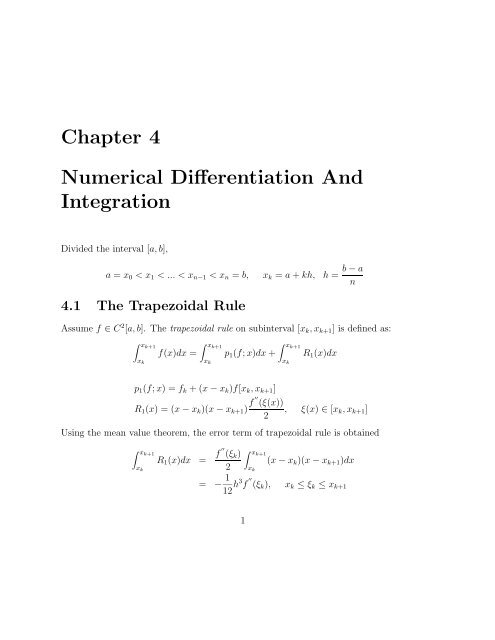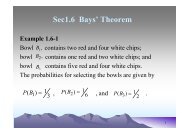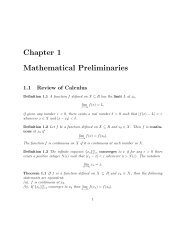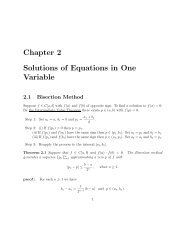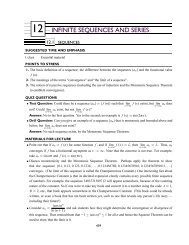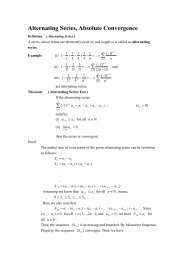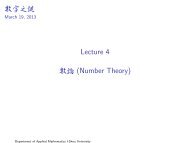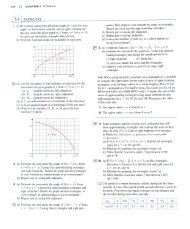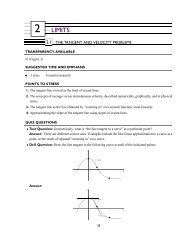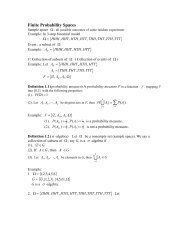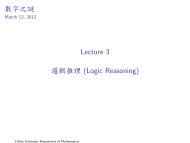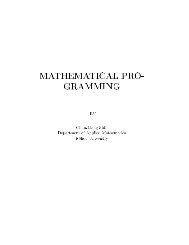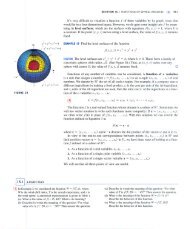Chapter 4 Numerical Differentiation And Integration
Chapter 4 Numerical Differentiation And Integration
Chapter 4 Numerical Differentiation And Integration
Create successful ePaper yourself
Turn your PDF publications into a flip-book with our unique Google optimized e-Paper software.
<strong>Chapter</strong> 4<br />
<strong>Numerical</strong> <strong>Differentiation</strong> <strong>And</strong><br />
<strong>Integration</strong><br />
Divided the interval [a,b],<br />
a = x 0 < x 1 < ... < x n−1 < x n = b,<br />
x k = a + kh, h = b − a<br />
n<br />
4.1 The Trapezoidal Rule<br />
Assume f ∈ C 2 [a,b]. The trapezoidal rule on subinterval [x k ,x k+1 ] is defined as:<br />
∫ xk+1<br />
∫ xk+1<br />
f(x)dx = p 1 (f;x)dx +<br />
x k x k<br />
∫ xk+1<br />
x k<br />
R 1 (x)dx<br />
p 1 (f;x) = f k + (x − x k )f[x k ,x k+1 ]<br />
R 1 (x) = (x − x k )(x − x k+1 ) f ′′ (ξ(x))<br />
, ξ(x) ∈ [x k ,x k+1 ]<br />
2<br />
Using the mean value theorem, the error term of trapezoidal rule is obtained<br />
∫ xk+1<br />
x k<br />
R 1 (x)dx = f ′′ (ξ k )<br />
2<br />
∫ xk+1<br />
x k<br />
(x − x k )(x − x k+1 )dx<br />
= − 1 12 h3 f ′′ (ξ k ), x k ≤ ξ k ≤ x k+1<br />
1
Then the trapezoidal rule is rewritten as:<br />
∫ xk+1<br />
The composite trapezoidal rule<br />
∫ b<br />
a<br />
f(x)dx =<br />
x k<br />
f(x)dx = h 2 (f k + f k+1 ) − 1 12 h3 f ′′ (ξ k )<br />
n−1 ∑<br />
k=0<br />
∫ xk+1<br />
x k<br />
f(x)dx<br />
= h 2 (f 0 + 2f 1 + ... + 2f n−1 + f n ) − 1 n−1 ∑<br />
12 h3<br />
The error term of composite trapezoidal integration rule is<br />
En T (f) = − 1 n−1 ∑<br />
12 h3 f ′′ (ξ k ) = − 1 [ 1<br />
12 h2 (b − a)<br />
n<br />
k=0<br />
= − 1 12 h2 (b − a)f ′′ (ξ)<br />
n−1 ∑<br />
k=0<br />
k=0<br />
f ′′ (ξ k )<br />
f ′′ (ξ k )<br />
]<br />
4.2 Simpson’s Rule<br />
f ′′ (ξ) = maxf ′′ (ξ k ), a ≤ ξ ≤ b.<br />
Assume f ∈ C 4 [a,b]. The Simpson’s rule on subinterval [x k ,x k+2 ] is defined as:<br />
∫ xk+2<br />
∫ xk+2<br />
f(x)dx = p 2 (f;x)dx +<br />
x k x k<br />
∫ xk+2<br />
x k<br />
R 2 (x)dx<br />
p 2 (f;x) = f k + (x − x k )f[x k ,x k+1 ] + (x − x k )(x − x k+1 )f[x k ,x k+1 ,x k+2 ]<br />
R 2 (x) = (x − x k )(x − x k+1 )(x − x k+2 )f[x k ,x k+1 ,x k+2 ,x]<br />
Note that, since (x − x k )(x − x k+1 )(x − x k+2 ) changes sign at x = x ± k+1 , it can not use<br />
the mean value theorem to obtain the error term, so define<br />
∫ x<br />
w(x) = (t − x k )(t − x k+1 )(t − x k+2 )dt<br />
x k<br />
w ′ (x) = (x − x k )(x − x k+1 )(x − x k+2 )<br />
2
Then w(x k ) = w(x k+2 ) = 0 and w(x) > 0 for x k < x < x k+2 . Therefore, the error term<br />
is obtained by integral by part and the mean value theorem<br />
∫ xk+2<br />
x k<br />
R 2 (x)dx =<br />
= −<br />
∫ xk+2<br />
x k<br />
∫ xk+2<br />
x k<br />
w ′ (x)f[x k ,x k+1 ,x k+2 ,x]dx<br />
w(x)f[x k ,x k+1 ,x k+2 ,x,x]dx<br />
= −f[x k ,x k+1 ,x k+2 ,ξ,ξ]<br />
= − 1 [ ] 4<br />
24 f(4) (ξ k )<br />
15 h5<br />
∫ xk+2<br />
x k<br />
w(x)dx<br />
∫ xk+2<br />
x k<br />
f(x)dx = h 3 (f k + 4f k+1 + f k+2 ) − 1 90 h5 f (4) (ξ k ), x k < ξ k < x k+2<br />
The composite Simpson’s rule for even n<br />
∫ b<br />
f(x)dx = h 3 (f 0 + 4f 1 + 2f 2 + 4f 3 + 2f 4 + ... + 4f n−1 + f n )<br />
a<br />
− 1<br />
180 h4 (b − a)f (4) (ξ).<br />
Note that the Simpson’s rule is exact for polynomial of degree ≤ 3.<br />
4.3 Newton-Cotes <strong>Integration</strong> Formulas<br />
∫ b<br />
∫ b n∑<br />
n∑<br />
I n (f) = p n (f;x)dx = l j,n (x)f(x j ) = w j,n f(x j )<br />
a<br />
a<br />
j=0<br />
j=0<br />
w j,n =<br />
∫ b<br />
a<br />
l j,n (x),<br />
j = 0, 1,...,n<br />
n = 1 I 1 = h [f(a) + f(b)] −h3<br />
2<br />
12 f ′′ (ξ)<br />
n = 2 I 2 = h [f(a) + 4f(a + h) + f(b)] −h5<br />
3<br />
90 f(4) (ξ)<br />
n = 3 I 3 = 3h 8<br />
[f(a) + 3f(a + h) + 3f(a + 2h) + f(b)] −3h5<br />
80 f(4) (ξ)<br />
3
Theorem 4.1 (a) For n even, assume f(x) ∈ C n+2 [a,b]. Then<br />
I(f) − I n (f) = C n h n+3 f (n+2) (η),<br />
C n =<br />
η ∈ [a,b]<br />
∫<br />
1 n<br />
µ 2 (µ − 1)...(µ − n)dµ<br />
(n + 2)! 0<br />
(b) For n odd, assume f(x) ∈ C n+1 [a,b]. Then<br />
proof :<br />
I(f) − I n (f) = C n h n+2 f (n+1) (η),<br />
C n =<br />
E n (f) = I(f) − I n (f) =<br />
η ∈ [a,b]<br />
∫<br />
1 n<br />
µ(µ − 1)...(µ − n)dµ<br />
(n + 1)! 0<br />
∫ b<br />
a<br />
(x − x 0 )(x − x 1 )...(x − x n )f[x 0 ,x 1 ,...,x n ,x]dx<br />
If n odd then (x − x 0 )(x − x 1 )...(x −x n ) is unchange sign on [a,b]. Using the mean value<br />
theorem we obtain the (b) easily. If n even, define<br />
w(x) =<br />
∫ x<br />
a<br />
(t − x 0 )(t − x 1 )...(t − x n )dt, w ′ (x) = (x − x 0 )(x − x 1 )...(x − x n ).<br />
Then w(a) = w(b) = 0 and w(x) > 0 for x ∈ [a,b]. Using the integral by part and the<br />
mean value theorem we obtain the error term<br />
E n (f) =<br />
∫ b<br />
a<br />
w ′ (x)f[x 0 ,x 1 ,...,x n ,x]dx = −<br />
= −f[x 0 ,x 1 ,...,x n ,ξ,ξ]<br />
= − f(n+2) (η)<br />
(n + 2)!<br />
∫ b<br />
a<br />
w(x)dx =<br />
∫ b ∫ x<br />
a<br />
a<br />
∫ b ∫ b<br />
a t<br />
∫ xn<br />
This completes the proof of theorem.<br />
∫ b<br />
a<br />
w(x)dx,<br />
∫ b<br />
a<br />
w(x)f[x 0 ,x 1 ,...,x n ,x,x]dx<br />
a ≤ ξ ≤ b<br />
(t − x 0 )(t − x 1 )...(t − x n )dtdx<br />
(t − x 0 )(t − x 1 )...(t − x n )dxdt<br />
= (t − x 0 )(t − x 1 )...(t − x n )(x n − t)dt<br />
x 0<br />
∫ n<br />
= −h n+3 µ(µ − 1)...(µ − n) 2 dµ<br />
0<br />
∫ n<br />
= −h n+3 µ 2 (µ − 1)...(µ − n)dµ<br />
0<br />
4
4.4 The Midpoint Rule<br />
Using Taylor’s expansion for f(x) ∈ C 2 [a,b] at c = (b + a)/2<br />
∫ b<br />
a<br />
f(x) = f(c) + f ′ (c)(x − c) + f ′′ (η)<br />
(x − c) 2 , a ≤ η ≤ b<br />
2<br />
f(x)dx =<br />
∫ b<br />
a<br />
f(c)dx +<br />
∫ b<br />
a<br />
f ′ (c)(x − c)dx +<br />
(b − a)3<br />
= (b − a)f(c) + 0 + f ′′ (η)<br />
24<br />
Then we obtain the midpoint integration formula<br />
∫ b<br />
a<br />
f(x)dx = (b − a)f( b + a<br />
2<br />
(b − a)3<br />
) + f ′′ (η),<br />
24<br />
∫ b<br />
a<br />
f ′′ (η)<br />
(x − c) 2 dx<br />
2<br />
η ∈ [a,b]<br />
For the composite midpoint rule define x j = a + (j − 1 )h, j = 1, 2,...,n, the midpoints of<br />
2<br />
[a + (j − 1)h,a + jh]. Then<br />
∫ b<br />
a<br />
f(x)dx = h[f 1 + f 2 + ... + f n ] +<br />
(b − a)h2<br />
f ′′ (η),<br />
24<br />
η ∈ [a,b]<br />
4.5 Gauss-Legendre Quadrature<br />
The generality integration formulas<br />
n∑<br />
I n (f) = w j,n f(x j,n ) =<br />
.<br />
j=1<br />
∫ b<br />
a<br />
w(x)f(x)dx = I(f) (4.5.1)<br />
The weight function w(x) is assumed to be nonnegative and integrable on [a,b]. The<br />
special case w(x) = 1,<br />
∫ 1<br />
f(x)dx . n∑<br />
= w j f(x j )<br />
−1<br />
j=1<br />
The weight {w j } and nodes {x j } are to be determined to make the error<br />
∫ 1<br />
n∑<br />
E n (f) = f(x)dx − w j f(x j )<br />
−1<br />
j=1<br />
equal zero for as high a degree polynomial f(x) as possible. Note that E n (f) = 0 for<br />
every polynomial of degree ≤ m if and only if E n (x i ) = 0, i = 0, 1,...,m.<br />
5
(1) n=1. Since there are two parameters w 1 and x 1 , we consider<br />
E n (1) = 0, E n (x) = 0<br />
∫ 1<br />
−1<br />
1dx − w 1 = 0,<br />
∫ 1<br />
−1<br />
xdx − w 1 x 1 = 0<br />
This implies w 1 = 2 and x 1 = 0. Thus the formula is the midpoint rule,<br />
∫ 1<br />
f(x)dx = . 2f(0)<br />
−1<br />
(2) n=2. There are four parameters w 1 , w 2 , x 1 , x 2 and thus we put four constraints on<br />
these parameters:<br />
E n (x i ) =<br />
∫ 1<br />
−1<br />
x i dx − [w 1 x i 1 + w 2 x i 2] = 0, i = 0, 1, 2, 3<br />
These lead to the unique formula,<br />
∫ 1<br />
f(x)dx = . f(− √ 3/3) + f( √ 3/3)<br />
−1<br />
(3) For a general n there are 2n free parameters {x i } and {w i }. The equations to be<br />
solved are<br />
E n (x i ) = 0, i = 0, 1, 2,..., 2n − 1<br />
These are nonlinear equations, and their solvability is not at all obvious.<br />
The quadrature formula (4.5.1) has degree of exactness d if E n (f) = 0 for all f ∈ P d .<br />
We call (4.5.1) interpolatory if it has degree of exactness d = n − 1. The interpolatory<br />
formula is precisely for which<br />
n∑<br />
∫ b<br />
w j f(x j ) = p n−1 (f;x 1 ,...,x n ;x)w(x)dx<br />
j=1<br />
a<br />
n∑<br />
n∏ x − x k<br />
p n−1 (x) = l j (x)f(x j ), l j (x) =<br />
j=1<br />
k=1,k≠j<br />
x j − x k<br />
w j =<br />
∫ b<br />
a<br />
l j (x)w(x)dx,<br />
j = 1, 2,...,n.<br />
6
Theorem 4.2 Given an integer k with 0 ≤ k ≤ n the quadrature formula (4.5.1) has<br />
degree of exactness d = n−1+k if and only if both of the following conditions are satisfied<br />
(a) The formula (4.5.1) is interpolatory.<br />
(b) The node polynomial ω n (x) = ∏ n<br />
j=1 (x − x j ) satisfies<br />
∫ b<br />
a<br />
ω n (x)p(x)w(x)dx = 0,<br />
∀ p ∈ P k−1<br />
proof : (⇒) Since d = n − 1 + k ≥ n − 1, condition (a) is trivial. For any p(x) ∈ P k−1 ,<br />
ω n (x)p(x) ∈ P n−1+k , hence<br />
∫ b<br />
n∑<br />
ω n (x)p(x)w(x)dx = w j ω n (x j )p(x j ) = 0<br />
a<br />
j=1<br />
since ω n (x j ) = 0, for j = 1, 2,...,n.<br />
(⇐) Given any p(x) ∈ P n−1+k divide it by ω n (x), so that<br />
p(x) = q(x)ω n (x) + r(x),<br />
q ∈ P k−1 , r ∈ P n−1<br />
∫ b<br />
a<br />
p(x)w(x)dx =<br />
∫ b<br />
a<br />
q(x)ω n (x)w(x)dx +<br />
∫ b<br />
a<br />
r(x)w(x)dx (4.5.2)<br />
The first integral on the right, by (b), is zero, since q ∈ P k−1 . By (a), since r = p −qω n ∈<br />
P n−1<br />
∫ b<br />
a<br />
n∑<br />
n∑<br />
n∑<br />
r(x)w(x)dx = w j r(x j ) = w j [p(x j ) − q(x j )ω n (x j )] = w j p(x j ) (4.5.3)<br />
j=1<br />
j=1<br />
j=1<br />
We obtain from (4.5.2) and (4.5.3)<br />
∫ b<br />
n∑<br />
p(x)w(x)dx = w j p(x j )<br />
a<br />
j=1<br />
Then E n (p) = 0. This completes the proof of theorem.<br />
7
• Gauss-Legendre quadrature<br />
∫ 1<br />
f(x)dx . n∑<br />
= w j f(x j )<br />
−1<br />
j=1<br />
For integrals on other finite intervals with weight function w(x) = 1, use the following<br />
linear change of variables:<br />
t =<br />
a + b + x(b − a)<br />
, dt = b − a<br />
2<br />
2 dx<br />
∫ b<br />
a<br />
f(t)dt =<br />
( ) b − a ∫ 1<br />
2<br />
f<br />
−1<br />
( )<br />
a + b + x(b − a)<br />
dx<br />
2<br />
n x i w i<br />
2 ± 0.5773502692 1.0<br />
3 ± 0.7745966692 0.5555555556<br />
0.0 0.8888888889<br />
4 ± 0.8611363116 0.3478546451<br />
± 0.3399810436 0.6521451549<br />
5 ± 0.9061798459 0.2369268851<br />
± 0.5384693101 0.4786286705<br />
0.0 0.5688888889<br />
6 ± 0.9324695142 0.1713244924<br />
± 0.6612093865 0.3607615730<br />
± 0.2386191861 0.4679139346<br />
7 ± 0.9491079123 0.1294849662<br />
± 0.7415311856 0.2797053915<br />
± 0.4058451514 0.3818300505<br />
0.0 0.4179591837<br />
8 ± 0.9602898565 0.1012285363<br />
± 0.7966664774 0.2223810345<br />
± 0.5255324099 0.3137066459<br />
± 0.1834346425 0.3626837834<br />
Note that go up to n = 512 in Stroud and Secrest (1966) Gaussian Quadrature<br />
Formulas, Prentice-Hall, Englewood Cliffs, N.J. .<br />
8
4.6 Extrapolation<br />
• Aitken extrapolation<br />
Assume that the integration formula has an error formula<br />
I − I n = c n p p > 0<br />
This is not always valid. Ex., Gaussian quadrature does not usually satisfy. The Aitken<br />
extrapolation has two steps:<br />
Step 1. Estimate p, using the following equation,<br />
I 2n − I n<br />
= (I − I n) − (I − I 2n )<br />
I 4n − I 2n (I − I 2n ) − (I − I 4n ) = (c/np ) − (c/2 p n p )<br />
(c/2 p n p ) − (c/4 p n p ) = 2p<br />
Step 2. To estimate the integral I with increased accuracy, suppose that I n , I 2n and I 4n<br />
have been computed.<br />
• Richardson extrapolation<br />
I − I n<br />
I − I 2n<br />
= 2 p = I − I 2n<br />
I − I 4n<br />
(I − I n )(I − I 4n ) = (I − I 2n ) 2<br />
I = Ĩ4n = I 4n −<br />
(I 4n − I 2n ) 2<br />
(I 4n − I 2n ) − (I 2n − I n )<br />
I − I n = d 2<br />
n + d 4<br />
+ ... (4.6.4)<br />
2 n4 multiply (4.6.4) by 4 and subtract from (4.6.5):<br />
I − I n/2 = 4d 2<br />
n 2 + 16d 4<br />
n 4 + ... (4.6.5)<br />
4(I − I n ) − (I − I n/2 ) = − 12d 4<br />
n 4 + ...<br />
9
I = 4I n − I n/2<br />
− 12d 4<br />
+ ...<br />
3 n 4<br />
Define Ĩ = (4I n − I n/2 )/3 then the error convergence order increasing from O(1/n 2 ) to<br />
O(1/n 4 ).<br />
• Romberg integration<br />
The Richardson’s extrapolation process can be continued inductively. Define<br />
I (k)<br />
n<br />
with n a multiple of 2 k , k ≥ 1.<br />
= 4k I n<br />
(k−1)<br />
I (0)<br />
1<br />
4 k − 1<br />
I (0)<br />
2 I (1)<br />
2<br />
− I (k−1)<br />
n/2<br />
I (0)<br />
4 I (1)<br />
4 I (2)<br />
4<br />
I (0)<br />
8 I (1)<br />
8 I (2)<br />
8 I (3)<br />
8<br />
... ... ... ...<br />
4.7 <strong>Numerical</strong> <strong>Differentiation</strong><br />
From the Newton’s interpolation polynomial,<br />
, n ≥ 2 k<br />
f(x) − p n (x) = Φ n (x)f[x 0 ,x 1 ,...,x n ,x], Φ n (x) = (x − x 0 )...(x − x n )<br />
f ′ (x) − p ′ n(x) = Φ ′ n(x)f[x 0 ,x 1 ,...,x n ,x] + Φ n (x)f[x 0 ,x 1 ,...,x n ,x,x]<br />
= Φ ′ n(x) f(n+1) (ξ 1 )<br />
(n + 1)!<br />
Thus let x j = x 0 + jh, j = 0, 1,...,n. Then<br />
+ Φ n (x) f(n+2) (ξ 2 )<br />
(n + 2)!<br />
Φ n (x) = O(h n+1 ), Φ ′ n(x) = O(h n )<br />
f ′ (x) − p ′ n(x) =<br />
{<br />
O(h n ) Φ ′ n(x) ≠ 0<br />
O(h n+1 ) Φ ′ n(x) = 0<br />
10
• Undetermined coefficients method<br />
We illustrate the method by deriving a formula for f ′′ (x). Assume<br />
f ′′ (x) . = Af(x + h) + Bf(x) + Cf(x − h)<br />
with A, B and C undetermined. Replace f(x+h) and f(x −h) by the Taylor expansions<br />
f(x ± h) = f(x) ± hf ′ (x) + h2<br />
2 f ′′ (x) ± h3<br />
6 f(3) (x) + h4<br />
24 f(4) (ξ ± )<br />
with x − h ≤ ξ − ≤ x ≤ ξ + ≤ x + h.<br />
Af(x + h) + Bf(x) + Cf(x − h) = (A + B + C)f(x) + h(A − C)f ′ (x)<br />
+ h2<br />
2 (A + C)f ′′ (x) + h3<br />
6 (A − C)f(3) (x) + h4 [<br />
Af (4) (ξ + ) + Cf (4) (ξ − ) ]<br />
24<br />
In order for this to equal f ′′ (x), we get<br />
A + B + C = 0, A − C = 0, A + C = 2 h 2<br />
This yields the formula<br />
A = C = 1 h 2,<br />
B = −2<br />
h 2<br />
f ′′ (x) =<br />
f(x + h) − 2f(x) + f(x − h)<br />
h 2<br />
− h2<br />
12 f(4) (ξ)<br />
4.8 Peano Representation of Linear functionals<br />
Suppose that f ∈ C d+1 [a,b]. Then by Taylor’s theorem we have<br />
f(x) = f(a) + f ′ (a)(x − a) + ... + f(d) (a)<br />
(x − a) d + 1 ∫ x<br />
(x − t) d f (d+1) (t)dt<br />
d! d! a<br />
The last integral can be extended to t = b if we replace x − t by 0 when t > x:<br />
{<br />
x − t if x ≥ t<br />
(x − t) + =<br />
0 if x < t<br />
11
∫ x<br />
a<br />
(x − t) d f (d+1) (t)dt =<br />
∫ b<br />
a<br />
(x − t) d +f (d+1) (t)dt<br />
Let E be a linear functional operator with E(p) = 0, ∀ p ∈ P d . Then<br />
E(f) =<br />
= 1 d!<br />
1 ( ∫ )<br />
b<br />
d! E (x − t) d +f (d+1) (t)dt<br />
∫ b<br />
a<br />
a<br />
E (x)<br />
(<br />
(x − t)<br />
d<br />
+<br />
)<br />
f (d+1) (t)dt<br />
Define the d-th Peano kernel for E as:<br />
K d (t) = 1 d! E ( )<br />
(x) (x − t)<br />
d<br />
+ , t ∈ R<br />
Thus we have the Peano representation of the functional E and K d .<br />
• Example<br />
E(f) =<br />
∫ b<br />
a<br />
K d (t)f (d+1) (t)dt<br />
12
4.9 Exercises<br />
1. Let p 2 (x) be the quadratic polynomial interpolating f(x) at x = 0, h, 2h. Use this<br />
to derive a numerical integration formula I h for I = ∫ 3h<br />
0 f(x)dx. Use a Taylor series<br />
expansion of f(x) to show<br />
I − I h = 3 8 h4 f (3) (0) + O(h 5 )<br />
2. Let t (2n)<br />
k be the nodes ordered monotonically of the (2n)-point Gauss-Legendre<br />
quadrature rule and w (2n)<br />
k the associated weights. Show that<br />
∫ 1<br />
0<br />
t −1/2 p(t)dt = 2<br />
n∑<br />
k=1<br />
w (2n)<br />
k<br />
p ([ t (2n) ])<br />
, ∀ p ∈ P2n−1<br />
3.(W.G., p.192, 5) Consider the integral I = ∫ 1<br />
−1 |x|dx whose exact value is evidently 1.<br />
Suppose I is approximated (as it stands) by the composite trapezoidal rule T(h)<br />
with h = 2/n, n = 1, 2, 3,....<br />
(a) Show (without any computation) that T(2/n) = 1 if n is even.<br />
(b) Determine T(2/n) for n odd and comment on the speed of convergence.<br />
4.(W.G., p.192, 7)<br />
(a) Derive the midpoint rule of integration<br />
∫ xk +h<br />
x k<br />
f(x)dx = hf(x k + 1 2 h) + 1 24 h3 f ′′ (ξ), x k ≤ ξ ≤ x k + h<br />
(b) Obtain the composite midpoint rule for ∫ b<br />
a f(x)dx including the error term<br />
subdividing [a,b] into n subintervals of length h = (b − a)/n.<br />
5.(W.G., p.194, 16)<br />
(a) Construct the weighted Newton-Cotes formula<br />
∫ 1<br />
0<br />
f(x) · x ln(1/x)dx ≈ a 0 f(0) + a 1 f(1)<br />
Hint: Use ∫ 1<br />
0 xr ln(1/x)dx = (r + 1) −2 , r = 0, 1, 2,....<br />
13<br />
k
(b) Discuss how the formula in (a) can be used to approximate<br />
∫ h<br />
g(t) · t ln(1/t)dt for small h > 0<br />
0<br />
6.(W.G., p.195, 17) Let s be the function defined by<br />
{<br />
(x + 1)<br />
3<br />
if − 1 ≤ x ≤ 0<br />
s(x) =<br />
(1 − x) 3 if 0 ≤ x ≤ 1<br />
(a) With △ denoting the subdivision of [−1, 1] into the two subintervals [−1, 0]<br />
and [0, 1] to what class S k m(△) does the spline s belong ?<br />
(b) Estimate the error of the composite trapezoidal rule applied to ∫ 1<br />
−1 s(x)dx<br />
when [−1, 1] is divided into n subintervals of equal length h = 2/n and n is<br />
even.<br />
(c) What is the error of the composite Simpson’s rule applied to ∫ 1<br />
−1 s(x)dx with<br />
the same subdivision of [−1, 1] as in (b).<br />
(d) What is the error resulting from applying the 2-point Gauss-Legendra rule to<br />
∫ 0<br />
−1 s(x)dx and ∫ 1<br />
0 s(x)dx separately and summing ?<br />
7.(W.G., p.195, 18)(Gauss-Kronrod rule) Let π n (·;w) be the (monic) orthogonal<br />
polynomial of degree n relative to a nonnegative weight function w on [a,b] and<br />
t (n)<br />
k its zeros. Use the theorem proved in class to determine conditions on w k , wk,<br />
∗<br />
t ∗ k for the quadrature rule<br />
∫ b<br />
a<br />
f(t)w(t)dt =<br />
n∑<br />
k=1<br />
w k f ( t (n)<br />
k<br />
to have degree of exactness at least 3n + 1.<br />
Hind: Replace in Theorem 4.2 n by 2n + 1.<br />
) n+1 ∑<br />
+ wkf(t ∗ ∗ k) + E n (f)<br />
k=1<br />
8.(W.G., p.198, 29) Let π n (·;w) be the n-th degree orthogonal polynomial with respect<br />
to the weight function w on [a,b], t 1 , t 2 , ..., t n its n zeros and w 1 , w 2 , ..., w n the n<br />
Gauss weights.<br />
(a) Assuming n > 1 show that the n polynomials π 0 , π 1 , ..., π n−1 are also orthogonal<br />
with respect to the discrete inner product<br />
n∑<br />
(u,v) = w j u(t j )v(t j )<br />
j=1<br />
14
(b) Denoting the elementary Lagrange interpolation polynomials associated with<br />
the nodes t 1 , t 2 , ..., t n<br />
l i (t) = ∏ k≠i<br />
t − t k<br />
t i − t k<br />
,<br />
i = 1, 2,...,n<br />
Show that<br />
∫ b<br />
a<br />
l i (t)l k (t)w(t)dt = 0,<br />
if i ≠ k<br />
9.(W.G., p.198, 30) Consider a quadrature formula of the type<br />
∫ ∞<br />
e −x f(x)dx = af(0) + bf(c) + E(f)<br />
0<br />
(a) Find a, b, c such that the formula has degree of exactness d = 2. Can you<br />
identify the formula so obtained ?<br />
Hind: ∫ ∞<br />
0 e −x x r dx = r!<br />
(b) Let p 2 (x) = p 2 (f; 0, 2, 2;x) be the Hermite interpolation polynomial interpolating<br />
f at the (simple) point x = 0 and the double points x = 2. Determine<br />
∫ ∞<br />
0 e −x p 2 (x)dx and compare with the result in (a).<br />
(c) Obtain the remainder E(f) in the form E(f) = const · f ′′′ (ξ), ξ > 0.<br />
10.(W.G., p.199, 34) Show that ∫ 1<br />
0 (1 − t)−1/2 f(t)dt when f is smooth can be computed<br />
accurately by Gauss-Legendre quadrature.<br />
Hind: Substitute 1 − t = x 2 .<br />
11.(W.G., p.178, Ex) Suppose in the approximate formula<br />
∫ 1<br />
0<br />
√ xf(x)dx = −<br />
2<br />
15 f(0) + 4 5<br />
derived in class the function f ∈ C 1 [0, 1].<br />
∫ 1<br />
0<br />
f(x)dx<br />
(a) Derive the appropriate Peano representation of the error functional E(f).<br />
(b) Obtain an estimate of the form |E(f)| ≤ c 0 ‖f ′ ‖ ∞ .<br />
12.(W.G., p.201, 42) Determine the quadrature formula of the type<br />
∫ 1<br />
∫ −1/2<br />
∫ 1<br />
f(t)dt = α −1 f(t)dt + α 0 f(0) + α 1 f(t)dt + E(f)<br />
−1<br />
−1<br />
having maximum degree of exactness d. What is the value of d?<br />
15<br />
1/2
13.(W.G., p.202, 47)<br />
∫ b<br />
n∑<br />
E(f) = f(x)dx − w k f(x k )<br />
a<br />
k=1<br />
is the error of a quadrature rule having degree of exactness d. Show that none of<br />
the Peano kernels K 0 , K 1 , ..., K d−1 can be definite.<br />
14.(W.G., p.203, 50)<br />
(a) Use the method of undetermined coefficients to construct a quadrature formula<br />
of the type<br />
∫ 1<br />
0<br />
f(x)dx = af(0) + bf(1) + cf ′′ (γ) + E(f)<br />
having maximum degree of exactness d the variables being a, b, c and γ.<br />
(b) Show that the Peano kernel K d for the formula obtained in (a) is definite and<br />
hence express the remainder in the form<br />
E(f) = e d+1 f (d+1) (ξ), 0 < ξ < 1.<br />
15. Let f ∈ C 4 derive the three-point midpoint numerical differentiation formula for<br />
f ′′ (c) with truncation error.<br />
f ′′ (c) =<br />
f(c + h) − 2f(c) + f(c − h)<br />
h 2<br />
− h2<br />
12 f(4) (ξ)<br />
16


